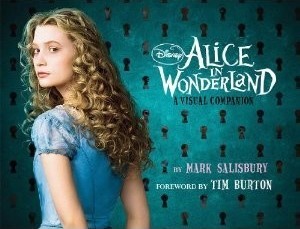
Having been continually disappointed by film adaptations of Alice’s Adventures in Wonderland and not a fan of the quirky darkness found in Burton films, his wildly popular “Alice in Wonderland” was on my “I’ll wait for the dvd” list. But Mark Salisbury movie making stories from “Disney’s Alice in Wonderland – A Visual Companion” convinced me to venture out to the theaters this weekend before the film disappears from screens. Unlike many behind the scenes books Alice in Wonderland – A Visual Companion was not released simultaneously with the film’s arrival in theaters so perhaps you missed picking up a copy. Within its pages you’ll discover the challenges the actors and filmmakers faced in maintaining an authenticity while bringing to life such an unusual world shedding light on the creative process. I particularly enjoyed viewing a collection of behind the scenes photographs that take you through Helena Bonham Carter’s makeup transformation into the Red Queen, a process that took nearly 3 hours each day. Costume designer Colleen Atwood shares her inspiration for the red queen’s wardrobe was the classic playing card but with a dash of tacky in keeping with the “camp court” found in the film.
An assortment of impressive concept images are showcased throughout the large-format book (approx 12”x9”). In many ways it reminds me of the various “Art of” books that have often accompanied Disney animated features. The length of the dust jacket interior offers Dermot Power’s illustration of the Oraculum, a graphic compendium of events in the world Alice discovers down the rabbit hole and I suspect will have more meaning to me after I’ve viewed the film. Burton used green-screen sets to bring that world to life filming those scenes over an eight week period. In some cases movie makers used the actor’s real head on a computer-generated body whose movements have been established through the actor’s performance capture suit worn during the shoot. The book does a fantastic job of putting the reader into these unique movie making experiences through numerous on-set images along with stills of the completed scene as it appeared in the movie. I found it a great introduction into how these types of movie are created and learned a lot about the varied roles computer imagery plays.
Mark Salisbury does a wonderful job bringing to light the actors’ experiences and inspirations. I enjoyed learning about the actors’ thoughts on the characters they portrayed and other characters as well such as discovering Johnny Depp’s favorite in the books were the Tweedles and Helena Bonham Carter’s initial concerns that she would be portraying the powerful and temperamental queen while simply clad in a green leotard. However it was the insight into many layers of the Mad Hatter’s creation that was most fascinating, the comparisons between Depp’s watercolor and Burton’s sketch of the character’s appearance (both featured in the book), the ease in solidifying not only the look but his portrayal of the character, and how Depp’s research into “mad as hatter” inspired various artistic elements of the characters’ actions, look including costume. Knowing that Johnny Depp was inspired to bring in elements of comedian Terry-Thomas (who Disney fans will recall voiced Sir Hiss in Robin Hood) I’m eager to see if I can spot those subtleties aside from the Thomas’ famous gap toothed grin. In many ways reading this book reminded me of when I first discovered the little nuances not hidden but not immediately realized on Disneyland attractions that give them their authenticity and has piqued my curiosity to discover the world beyond the rabbit hole yet again.
